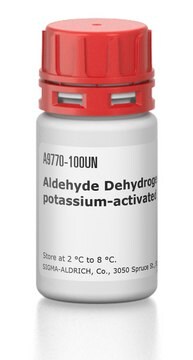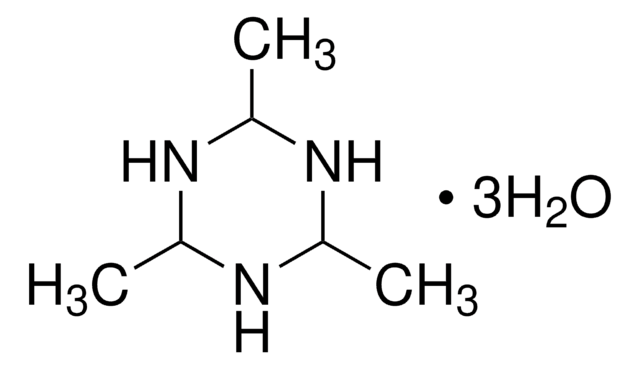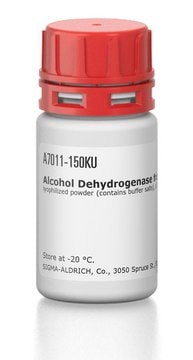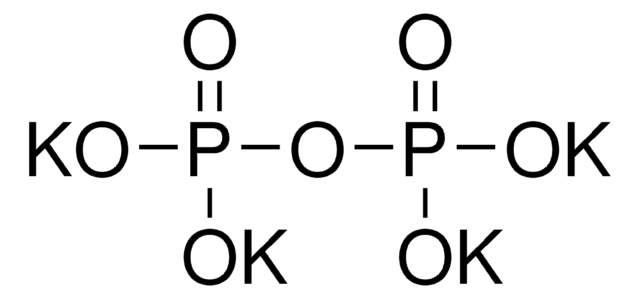Alle Fotos(3)
Wichtige Dokumente
A6338
Aldehyd-Dehydrogenase, Kalium-aktiviert aus Backhefe (S. cerevisiae)
lyophilized powder, ≥2.0 units/mg protein
Synonym(e):
Aldehyd:NAD[P]+-Oxidoreduktase
Anmeldenzur Ansicht organisationsspezifischer und vertraglich vereinbarter Preise
Alle Fotos(3)
About This Item
Empfohlene Produkte
Form
lyophilized powder
Qualitätsniveau
Spezifische Aktivität
≥2.0 units/mg protein
Mol-Gew.
228 kDa
Zusammensetzung
Protein, ≥5.0% biuret
Versandbedingung
dry ice
Lagertemp.
−20°C
Allgemeine Beschreibung
Aldehyde dehydrogenase is a tetramer and has several different isoforms. The enzyme tested in 0.01 M pyrophosphate buffer shows a sharp optimum around pH 9.3 with acetaldehyde as substrate. Potassium ions and cysteine are essential for the enzyme′s activity. Rubidium or NH4+ can be substituted for K+, and glutathione for cysteine. Lithium, Na+, and Cs+ inhibit the reaction. Aldehyde dehydrogenase is inhibited by propylurea, crotonaldehyde, n-propyl isocyanate, cyclohexyl isocyanate, 1-n-propyl-1-[(4-chlorophenyl)sulphonyl]-3-n-propylurea, and 1-methyl-1-[(4-chlorophenyl)sulphonyl]-3-n-propylurea. The enzyme may be utilized to quantitate aldehydes present in blood.
Aldehyde dehydrogenase (ALDH) is present in the nucleus, cytosol, mitochondria and endoplasmic reticulum of cells.
Anwendung
Aldehyde dehydrogenase (ALDH) has been used to evaluate the effects of pear extracts on ALDH activity. It has also been used to colorimetrically determine ethanol by monitoring the enzymatic reduction of nicotinamide adenine dinucleotide (NAD).
Biochem./physiol. Wirkung
Aldehyde dehydrogenase from baker′s yeast catalyzes the reduction of pyridine nucleotides by several aldehydes. It catalyzes the oxidation of a wide range of substrates, such as acetaldehyde, formaldehyde, propionaldehyde, n-butylaldehyde, isobutylaldehyde, n-valeraldehyde, caproaldehyde, benzaldehyde, glycoaldehyde, D-glyceraldehyde, malonic semialdehyde, and succinic aldehyde. Aldehyde dehydrogenase is used to study the production of ethanol and isobutanol. Ethanol concentration can be determined colorimentrically by monitoring the enzymatic reduction of nicotinamide adenine dinucleotide (NAD) using alcohol dehydrogenase after preremoval of aldehyde by aldehyde dehydrogenase.
Einheitendefinition
1 U oxidiert 1.0 μmol Acetaldehyd zu Essigsäure pro Minute bei 25 °C und pH 8.0 in Anwesenheit von β-NAD+, Kalium und Thiolen.
Physikalische Form
Enthält Trehalose, Kaliumphosphat und Citrat-Puffersalze, Dithiothreitol und Spuren von β-NAD und Propionsäure.
Rekonstituierung
This enzyme can be dissolved at 0.3 mg/mL in 100 mM Tris-HCl buffer (pH 8.0), containing 0.02% BSA.
Lagerklassenschlüssel
11 - Combustible Solids
WGK
WGK 3
Flammpunkt (°F)
Not applicable
Flammpunkt (°C)
Not applicable
Persönliche Schutzausrüstung
Eyeshields, Gloves, type N95 (US)
Hier finden Sie alle aktuellen Versionen:
Besitzen Sie dieses Produkt bereits?
In der Dokumentenbibliothek finden Sie die Dokumentation zu den Produkten, die Sie kürzlich erworben haben.
Kunden haben sich ebenfalls angesehen
Enzymic determination of acetaldehyde in blood.
F LUNDQUIST
The Biochemical journal, 68(1), 172-177 (1958-01-01)
Monoamine oxidase A activity in fibroblasts as a functional confirmation of MAOA variants.
Tessa M A Peters et al.
JIMD reports, 58(1), 114-121 (2021-03-18)
A two-stage, two-organism process for biohydrogen from glucose
Redwood MD and Macaskie LE
International Journal of Hydrogen Energy, 31(11), 1514-1521 (2006)
Sergey Stolyar et al.
Molecular systems biology, 3, 92-92 (2007-03-14)
The rate of production of methane in many environments depends upon mutualistic interactions between sulfate-reducing bacteria and methanogens. To enhance our understanding of these relationships, we took advantage of the fully sequenced genomes of Desulfovibrio vulgaris and Methanococcus maripaludis to
Effects and action mechanisms of Korean pear (Pyrus pyrifolia cv. Shingo) on alcohol detoxification.
Ho-Sun Lee et al.
Phytotherapy research : PTR, 26(11), 1753-1758 (2012-03-28)
Korean pear (Pyrus pyrifolia cv. Shingo) has been used as a traditional medicine for alleviating alcohol hangover. However, scientific evidence for its effectiveness or mechanism is not clearly established. To investigate its mechanism of alcohol detoxification, both in vitro and
Unser Team von Wissenschaftlern verfügt über Erfahrung in allen Forschungsbereichen einschließlich Life Science, Materialwissenschaften, chemischer Synthese, Chromatographie, Analytik und vielen mehr..
Setzen Sie sich mit dem technischen Dienst in Verbindung.








